Videogames’ Stuff and Things: EON GCHD MK-II
Early this year, we published an interview with the folks at EON Gaming, a small company dedicated to helping people enjoy their retro consoles on their modern displays. As a retro enthusiast myself I was intrigued by EON’s gear, despite being really into the CRT vibe. I was really curious, learning how devices like the […]
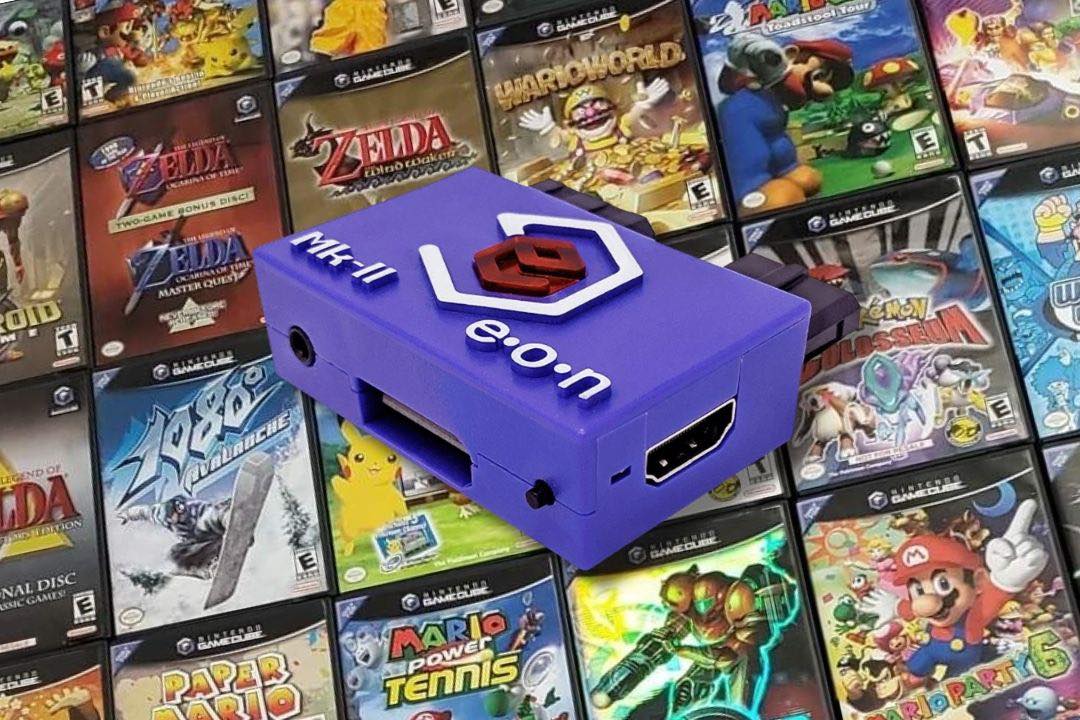
Early this year, we published an interview with the folks at EON Gaming, a small company dedicated to helping people enjoy their retro consoles on their modern displays. As a retro enthusiast myself I was intrigued by EON’s gear, despite being really into the CRT vibe. I was really curious, learning how devices like the GCHD worked, to see what it looked like firsthand. A few weeks later, I had a GCHD MK-II in the mail, in its cute little GameCube box. I was all set to hook the GameCube I found at a pawn shop a couple years ago to my monitor, then possibly my living room TV. But then, I learned something important.
See, I know a lot about games, but one of my blind spots is random hardware revisions. Turns out there was a second GameCube model, with the revision being all the extra ports yanked out! And that’s the one I had! So, my first GCHD adventure was getting a hold of an older model GameCube. Now I have two GameCubes, and neither one is the console I had as a preteen. Welp.
EON GCHD MK-II Review
Anyway, once that drama was solved, I was able to test this bad boy out. The GCHD MK-II fits into the GameCube’s digital and analog out ports, the former being the one missing from my other unit. But I was able to fit it snugly into this one, and play some HD GameCube. Unfortunately, I don’t have a universal remote with which to test the IR menus, so just the out of box function was available for me. And after just a few hours fiddling around with the GCHD, my different displays and… something else I may have set up with a Micro SD card (don’t tell Mr. Nintendo), I was pretty shocked!
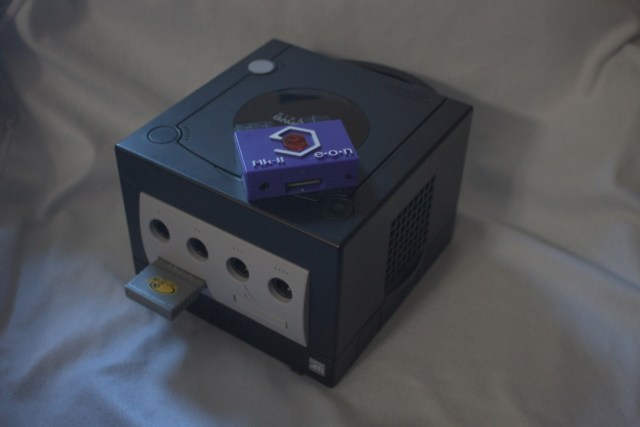
Basically, this device is like having the ludicrously expensive GameCube component cables in a tiny box, with HDMI and Wii SCART ports. Obviously it’s more complicated than that (custom firmware!), but to the outside layman, that’s what you see with your eyeballs. The end result is up to a 480p signal beamed to your display, with seriously imperceptible (if any at all) input lag. It rules, because it takes full advantage of the GameCube’s “Progressive Scan” capability.
Related: Interview: EON Gaming Talks Nintendo Switch Online, Official Emulation Woes and HD Retro Gaming
Not every game supports it (dang it, Skies of Arcadia!), but the ones that do look incredible. It’ll take some adjusting on the display itself to get everything just right, but the clarity and sharpness of that 480p image is shocking coming from a 2001 Nintendo console if you haven’t seen it before. I’m no expert photographer, but I did my best to capture what this looks like, and what the difference is. So, take some of these images with a little grain of salt, but they’re pretty close.
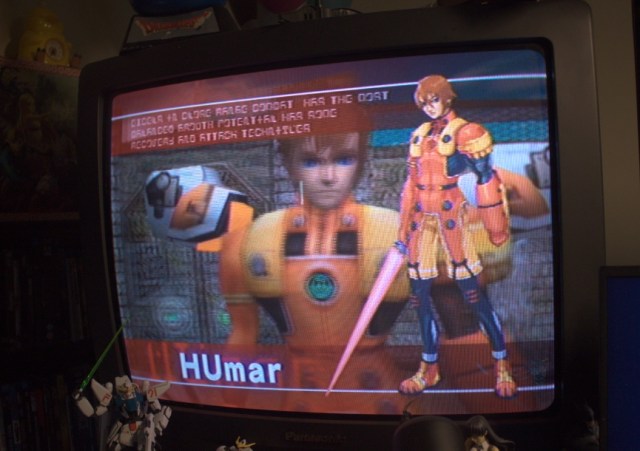
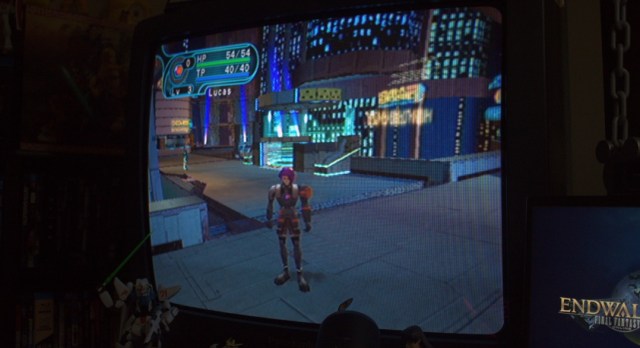
So, there’s Phantasy Star Online running on my CRT, a solid Panasonic that is far from an expensive Sony monitor, but does the job quite well. Man, there’s something about the way 2D art looks on a CRT that just hits me right in the goodfeels. The 3D stuff I can give or take. But that’s why PSO is a great example. The next example is Skies of Arcadia, which I think is the only game I have that doesn’t support progressive scan (without some… assistance). The rest of these images are from using the GCHD MK-II with a 65-inch LG NanoCell display.
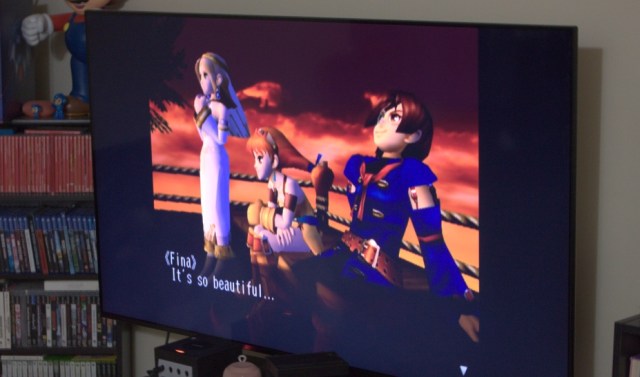
The image is a little washed out, because getting shots of this game in particular was just not agreeing with my camera (a Canon EOS REBEL Ti, for the record), no matter how many knobs I turned or buttons I pressed. But it’s pretty decent, especially in these cutscene-like moments. There’s a noticeable blurriness during actual gameplay though, but that’s more on the game than the hardware. And I can say that, because PSO definitely does support Progressive Scan and it looks fuckin’ sweet.
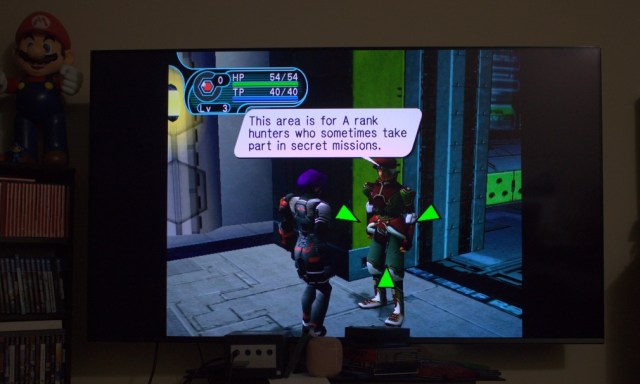
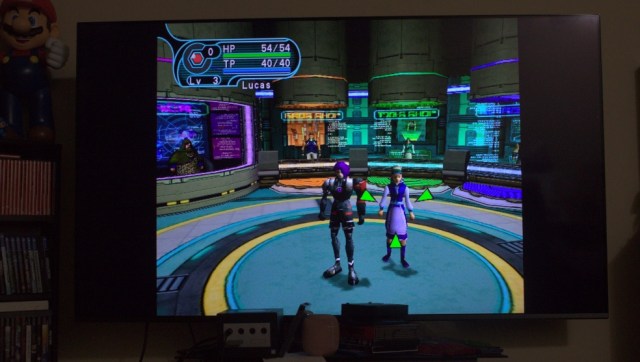
Look at how clear that text is! I couldn’t believe I was seeing clear, fully legible text from a GameCube game coming from the actual console. Normally you’d need an emulator to get a game like this to look this sharp on a 4K screen. No tricks, no latency, just a nice-looking videogame that’s like 20 years old.
I noted that GameCube component cables are expensive, and they certainly are. The GCHD MK-II isn’t cheap either, at a $149.99 MSRP. But that’s half the price (on a lucky day) for a device that works with any HDMI display you throw it at. The results are clear, even in my crappy amateur photos. I’ve never actually seen a GameCube game like this on a TV screen, much less from the original hardware. At least for this console, the GCHD MK-II will be the way I play going forward. I’d be skeptical about a similar device for much older platforms, but if EON ever expands its product line to PS1/2 or Dreamcast, sign me the heck up.
Related: Interview: CRT Pixels’ Jordan Starkweather Tells Us Why Retro Games Need Retro Screens
For now, you can get the GCHD MK-II in a few different colors at several retailers. EON’s other device is the Super 64, which performs similar audiovisual wizardry with Nintendo’s first 3D console. This device works without any hardware mods and without any additional power requirements. There’s even a 3.5 AUX jack on the back, because why not? If you do decide to snag one of these, just don’t forget your GameCube needs to be a model DOL 001, otherwise you won’t have the second port needed.
